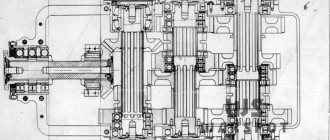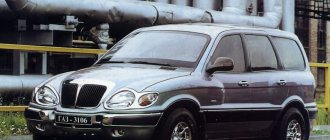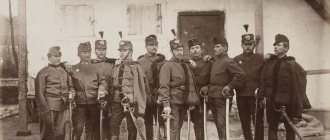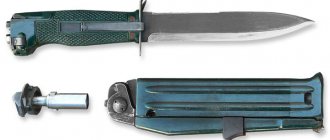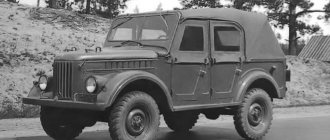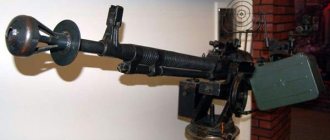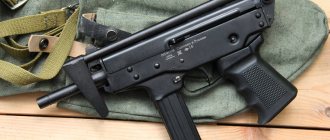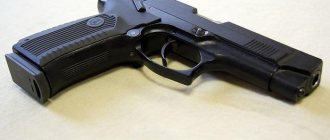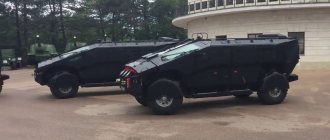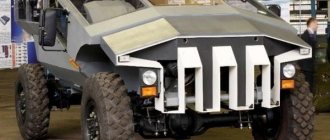With the development of mechanical engineering, army infantry became increasingly mechanized. The use of combat vehicles and armored personnel carriers showed its effectiveness even during the Second World War. The main emphasis was on supporting tank offensives with infantry.
In addition to large-scale offensives, combat vehicles were also valued in small sabotage operations. Armor, weapons, mobility of landing troops - all this made this technology relevant against small pockets of resistance. As a result, security services began to adopt them.
"Falcatus" is an FSB armored vehicle designed for assault operations. It entered service recently and many aspects continue to improve. Technical characteristics also remain in question; available information may be unreliable.
Design of a special forces armored car
“Falcatus” in service with the TsSN FSB
The design of the armored vehicle is made in a non-standard manner, partly reminiscent of a jeep, which is why many observers are skeptical about the appearance. The front of the hull is made at an acute angle to counteract frontal fire. The windshield is divided into three parts.
Armor plate
According to some sources, the armor of the assault vehicle corresponds to the sixth class. The suspension and bottom are protected, which allows you to overcome mines with minimal risk. The glass is also armored; there is evidence of its ability to withstand shots from SVD.
Surveillance and communications equipment
There is no information about the external and internal communications equipment of the Falcatus armored car. Taking into account the use of machines, it is assumed that communication equipment should provide both communication between groups and units, and coordination of actions with air cover.
When it comes to surveillance, the layout of the vehicle and the body are taken into account. The sharp bow and small window openings do not provide good line of sight at close range. Instead, cameras are used to display images on screens. Six such devices are already known.
Engine and transmission
The engine and most of the transmission components are located in the front of the vehicle under an armored hood. The turbodiesel power plant of the Tutaevsky Motor Plant model 8431.10 is used. Volume - 17.2 l, power - 830 l. s., maximum torque - 2550 Nm. The transmission is robotic and has a twelve-speed ZF gearbox.
Chassis
The Falcatus armored vehicles are built on the KamAZ-4911 Extreme chassis with a 4x4 wheel arrangement. Given the large mass of the body, the suspension received significant reinforcement. Each wheel has a pair of dual hydraulic shock absorbers. On later models, protective covers are installed for the wheels.
Number of passenger seats
"Falcatus" is designed to transport 10-12 people, including the driver and group commander. According to available information, the seats are located with their backs to the longitudinal axis of the vehicle, which allows soldiers to observe their surroundings.
The exit of the landing party is provided through the side and stern doors; there is a hatch in the roof. The side doors open in a reversible pattern - front forward, rear backward. This protects the Special Forces soldiers as they exit from both sides.
ZIL "Punisher" - the last attempt of the Likhachev Plant to maintain production
The Moscow Likhachev Plant remained the flagship of Soviet truck production for many decades. But in addition, ZIL periodically produced new models of government limousines, and even sports cars for racing.
But in the early 1990s, the plant had to sharply reduce production volumes, since after the collapse of the Soviet Union all ties with the former republics were severed. Gradually, the plant's production of trucks decreased from 200,000 per year to several thousand units per year.
But today I want to tell you about the latest attempt by the Likhachev Plant to show that there are still outstanding designers left there who are capable of creating unique machines. In 2012, ZIL, which was already sentenced to demolition in 2011, created the “Punisher” armored car, intended for possible use in the Russian Armed Forces and sale to the armies of other countries. Of course, all this was only in plans, since the resources of the dying plant would definitely not be enough to launch even small-scale production of the new model.
The prototype of the “Punisher” armored car had a Cummins diesel engine developing 185 hp and an automatic five-speed gearbox. If we managed to interest the Russian army in our armored car, then in the future it was planned to install a powerful diesel engine of the YaMZ 7E846 brand, developing 730 hp, or YaMZ 7E846.10-07, developing 830 hp.
For those who don’t know, YaMZ 7E846 engines are installed on sports KamAZ trucks, although the manufacturer assures that it can install these engines on request on any suitable truck.
The armored car "Punisher" has axles and suspension from KamAZ with all-wheel drive, and the transfer case is also taken from this car. Previously, the management of the Likhachev Plant would have laughed at those who said that the new ZIL models would be made from components from other models from third-party manufacturers, but in 2012 the situation at the plant was deplorable, and in 2013 it was declared bankrupt, so It’s surprising that the opportunity was found to create a new car model, and such an interesting and highly specialized one.
The ZIL “Punisher” armored car has a length of 6330 mm, a height of 2566 mm and a width of 2397 mm. The weight of the armored car is 4.5 tons without mounted armor, and about 8 tons with a full set of armor. The belly of this miracle vehicle can accommodate 10 people, including the driver and commander of the armored vehicle. The crew sits in the front, and the paratroopers are placed in their own compartment, and they sit in such a way as to provide full all-round visibility.
All the windows in the Punisher armored car are armored; they are divided into sections and located at an angle to reduce the likelihood of penetration from small arms. The maximum speed of the armored vehicle is at least 120 km/h on the highway and about 30 km/h on dirt roads.
The car was equipped with a video review system consisting of 6 cameras, with two of them simultaneously serving as rear-view mirrors. All cameras can operate in night mode.
Unfortunately, this project could not save ZIL, and the car remained in a single copy. But after a couple of years, the car suddenly surfaced on KamAZ, only under the name “Falcatus”. I know for sure that at least two of these armored cars are used by the Chechen SOBR. This is the story of the latest attempt to revive ZIL.
Other FSB car models
Special forces under the cover of "Falcatus"
The FSB model range of armored vehicles has already changed several names during its design and production. In conditions of heightened secrecy, it is unknown which of them are official and which were invented by the media. There is also no exact data on the serial production of branches of the model range.
chastener
The armored car "Punisher" is one of the most common names of the vehicle. This is exactly the name that was given in 2012, when it became known to the general public. Later the project was officially renamed “Falcatus”.
Bug
“Bedbug” are early examples of armored vehicles, developed in the early 2000s. The name was received for the characteristic appearance reminiscent of this insect.
Anti-gradient
“Antigradient” is one of the armored car models that was supposed to go into mass production. It is unknown whether the secret project remained frozen or whether it was combined with other design solutions to create the later Falcatus.
YaMZ-7E846: Punisher vehicle and TsSN tank vehicle
The last few years have been marked by the fact that the latest modifications of vehicles intended for the military began to be produced. This trend raises certain questions and speculations among many, but there is no doubt that this is of increased interest.
The name “Punisher” appeared only a couple of years ago, but has already managed to cause a lot of discussion. All the talk, in part, was due to the fact that there was extremely little reliable information about the various characteristics, scope of application, and simply about the appearance of this car.
Technical characteristics of "Falcatus"
It is undeniable that the armored car is made according to the 4X4 scheme, presumably based on the KAMAZ-4911 rally truck. These trucks are equipped with YaMZ-7E846 engines with a power of 730 hp. With. Given the estimated weight of the armored car at 12 tons, such indicators may be unnecessary, so the engine may be less powerful. When using this engine, you can accelerate the car to 200 km/h, which can sometimes be useful.
- Empty weight - 12 t
- Gross curb weight - 15.42 t
- Wheel formula - 4x4
- Maximum speed - 200 km/h
- Maximum lift angle - 36 degrees
- Maximum landing party - up to 12 people with driver
Engine
- Engine - YaMZ-7E846, V-shaped
- Type - diesel
- Number of cylinders - 8
- Engine capacity - 17 liters
- Engine power - 730 hp. at 2500 rpm
- Maximum torque - 2700 Nm, at 1200-1400 rpm
Sword or ancient shark
The cars, noticed and filmed by folk craftsmen in the spring of 2015, clearly differ from the skinny “Bedbug” in their brutal appearance. This is a similar, but completely different armored vehicle - the Falcatus, which is apparently being developed jointly with KAMAZ by the Moscow Fort Technology CJSC in the interests of the Special Purpose Center (TsSN) of the FSB. KAMAZ does not confirm its participation in the development of the armored car, but does not deny it either. There is not a word on the official website, however, the website of Fort Technology CJSC is generally “under development.”
The armored car is named after the curved Celtic sword - Falcatus or Falcata. If someone likes fauna more, then Falcatus is also the ancestor of the modern shark, who lived 320 million years ago. Well, flora lovers can derive the name from the indoor flower Asparagus Falcatus.
https://youtube.com/watch?v=9JaAv8IO9Xo
As a matter of fact, Fort Technology CJSC is, first of all, a developer, manufacturer and supplier of bulletproof equipment. According to media reports, the company has developed and put into production a number of ballistic materials and armor compositions for body armor and bulletproof helmets.
The equipment developed and produced by the company is used by the FSB and FSO, in particular the Grenadier and Defender body armor. It can be assumed that Fort Technology CJSC develops, first of all, armor and structural protection elements. By the way, the model of the “Bedbug” did not have any armor.
History of creation
Work on an armored car for the special purpose center of the Federal Security Service (TSSN FSB) began back in 2002. According to unofficial data, the first prototype was designed at AMO "ZiL" and was called "Bedbug", as the designers dubbed it because of its unusual appearance. In 2009, a complete model of the “Bedbug” was assembled. But due to unknown disagreements, the assembly took place not at the ZiL plant, but at the KamAZ enterprise. Because of this, the technology was not followed and the model was dismantled. It is unknown when they returned to the design, but in the spring of 2012 the first photographs of this machine were published along with some technical parameters, which caused a strong reaction in society. During this time, the armored car changed its name to “Falcatus” (official), but the press dubbed it much more menacingly - “Punisher”.
Falcatus is a type of sword, which indicates the purpose of the machine. True, the information about the technical parameters is too scarce for one to get a complete picture of the armored car; most of the information about it is guesswork based on photographs. So from the photographs you can see that the car belongs to the TsSN FSB. Due to lack of information, Falcatus was gradually forgotten.
The second wave of discussions began after the Falcatus, along with the Viking armored car, appeared on the road in Tatarstan in May 2015. Gradually, photographs began to appear from other regions of Russia, and in February 2016, “Falcatus” appeared on television, during its presentation to Vladimir Putin. The new machine was modified by specialists from Fort Technology CJSC. In the same video, the director of the Russian FSB, Alexander Bortnikov, stated that the Falcatus armored car is an anti-guerrilla vehicle.
Usage
Universal Soviet armored car ba-64
Macedonian hoplite with falcata.
Falcata is a special blade; due to its shape, its center of gravity is strongly shifted towards the tip. This provides a very strong, effective slash that is comparable in strength to an ax blow. Because of the same center of gravity, the hand holding the falcata did not slip onto the blade, hence the lack of a full guard, and the presence of a beak-shaped pommel of the handle so that the sword would not tear out of the hand. Also, because of the reverse bend, cutting movements on the reverse stroke of the blade were effective. A cutting movement with a straight blade or a blade with a normal curve requires some force to press the blade to the body. A blade with a reverse bend requires almost no such effort. The sharp end also allowed piercing blows. True, the fact that the tip is located significantly “lower” than the handle made the piercing blow quite difficult. It can be assumed that the falcata technique was based on chopping movements. The falcata was worn on the belt, with the sharpened side down.
| Armament of Roman legionnaires | |
| Armor: | |
| Helmets: | |
| Shields: | Scutum • Parma • Clypeus |
| Polearm weapons: | Gasta • Pilum • Plumbata • Lancea |
| Bladed weapons: |
Armored car ZIL “Punisher” - technical characteristics and development history
A year ago, a futuristic-looking car was spotted on Russian roads, clearly intended for the army or law enforcement agencies. The car immediately aroused considerable interest, primarily due to its formidable and unusual design. It is called “Punisher” and is the latest development of the domestic automobile industry for the Russian Armed Forces.
The history of the armored car "Punisher" dates back to November 2001, when, in accordance with the decision of the plenum of the Scientific and Technical Committee of the Main Automotive Armored Directorate (GABTU) of the Russian Ministry of Defense and technical assignment No. 2-99 dated April 15, 2002, a number of the country's automobile plants were invited to participate in Research work on the topic “Punisher”, which involves the development of a technical design for a family of multi-purpose army vehicles with a carrying capacity of 1 to 2.5 tons in 2010-2015. AMO "ZIL" also entered the circle of those organizations that were involved in the project on a competitive basis.
However, at the end of the year, the management of the enterprise, citing the busyness of the design and technical services and pilot production of the plant with the design and construction of prototypes of army vehicles of the 4x4 and 6x6 types (with a carrying capacity of 2.5 and 4 tons, respectively) on the topic “Kalam” , notified the Ministry of Defense that AMO ZIL would not be able to fully participate in the work on the new project. And yet, 5 years later, at the beginning of 2008, the mayor of Moscow Yu. Luzhkov instructed the general director of the managing organization of Moscow Automobile Company (MAK) CJSC K. Laptev to return on his own initiative to the above topic, taking into account the previously prepared tactical and technical assignment Ministry of Defense.
Having received the consent of the military department, in April of the same year, ZIL began developing a preliminary design for a family of 4×4 multi-purpose vehicles with a carrying capacity of 2.5 tons in accordance with the “Punisher” theme. The new model received the designation ZIL-3901.
On the one hand, the fleeting actions of various military formations on large bridgeheads using the latest weapons and equipment, using automated control of the entire process of combat operations (Desert Storm, 1991; Free Iraq, 2003) have become fundamentally new. ).
On the other hand, internal armed conflicts on an ethnic and religious basis have become more frequent, which are characterized by terrorist acts, often occurring on the streets of towns and cities and even on individual objects and in residential buildings. This required the creation of special forces equipped with highly effective countermeasures to seize objects inside peaceful territories. In accordance with changes in war technology, military equipment must also change.
Crew location
The external architecture and interior of the “Punisher” armored car were created by A. Chirkov and S. Sahakyan. The latter, together with the deputy director for development of AMO ZIL, the project manager of the engineering company S. Oshurkov, developed the general layout of the chassis and body of the vehicle.
The layout and placement of the units was carried out by the leading design engineer A. Stepanov, and the arrangement of the crew (fighters) back to back was suggested by K. Potekhin. V. Mazepa, deputy chief designer of AMO ZIL, was appointed head of the development of the preliminary design and running model. It must be said that a car with a single-volume body of an original design, which became the brainchild of a group of young designers, appeared in an unusually short time for such a product. The work from the first sketch to the construction of a running landing model was completed from May to September 2009.
During the design of the armored car "Punisher", AMO "ZIL" interacted with various specialized organizations, such as RSC Energia, MAMI, JSC Fort Technology, Research Institute of Steel, JSC Institute of Plastics named after. G.S. Petrov", MSTU im. Bauman, Scientific and Technical Center "Multiset", Research Institute-21 of the Ministry of Defense of the Russian Federation, etc. At the same time, analytical material on multi-purpose vehicles of foreign and domestic production was collected and summarized, research was carried out on the tactical and technical characteristics and driving characteristics of promising models together with units of combined arms services, the FSB , Airborne Forces and Ministry of Internal Affairs.
The design of the model of the Punisher car was developed using 3D computer technology, involving a limited number of performers. This allowed us to dramatically improve quality and significantly reduce project completion time. The design was carried out taking into account trends in the automotive industry associated with the replacement of cast parts with sheet bent-welded spatial structures, which, in addition to simplifying the production of a prototype, make it possible to obtain more durable (rigid) parts with less weight.
In January 2009, in the ZIL model shop, a model of the Punisher armored car was made on a scale of 1:10 from aluminum alloy, taking into account the fundamental layout parameters: the distance from the supporting surfaces of the wheels to the upper flanges of the frame side members - 1000 mm; front and rear wheel track – 2100 mm; wheelbase size – 3800 mm. When developing the design of the car body (December 2008 - January 2009), the landing of the crew was carried out according to the 1 + 10 scheme, but after correcting the mannequin models and agreeing with potential customers, the crew was reduced to 1 + 9.
The driver's and commander's seats are located in the front of the body, on the sides of the frame behind the engine line. Six crew members are placed back to back on the frame along the longitudinal axis. The two crew members are positioned facing backwards in a row between the rear wheel arches. This landing provides all-round visibility and the ability to conduct combat around the entire perimeter.
Quick exit from the body is made possible thanks to the wide door openings. Soldiers can easily leave the vehicle thanks to the wide door openings. Soldiers can easily leave the vehicle thanks to the wide door openings. The artistic and design solution for the armored car is based on the idea of creating a unique, ultra-modern, menacing and aggressive image of an SUV that performs not only the utilitarian functions of an armored car, but is also an effective psychological weapon.
Advantages and disadvantages
Tests and use in real combat conditions showed the advantages of the Falcatus armored car. The vehicle is capable of not only overcoming heavy enemy fire, but also delivering troops to the desired point, storming and breaking through obstacles, and clearing the way through minefields.
Given the small amount of information about the Falcatus machines, it is difficult to talk about shortcomings. The most significant point is the visibility of such a car
Made in black and red colors, it attracts everyone's attention on any road, which calls into question the secrecy of the operations being carried out.
They also pay attention to the names of the cars, their negative coloring and non-Russian origin. Many people associate “Punisher” with the German occupation, although there is also no exact information about the official nature of this name.
The “bug” is a bloodsucker, which also does not add to people’s faith in the security service.
Falcata was the name given to a sickle-shaped sword from the times of Ancient Rome, which became widespread in Iberia. The name was given to it only in the 19th century; it was also the name given to a prehistoric extinct fish. What connection there is with the armored car still remains a mystery.
Return
The second appearance of the car took place three years later - in the late spring of 2015. Several “Punishers” were immediately noticed on one of the highways in Tatarstan, where they calmly moved in the general flow. The corresponding photos and videos immediately spread around the network.
Observers immediately noticed some changes in the appearance of the car, including its dimensions. It was also assumed that the chassis and power plant were also modified.
At the same time, a new name for the armored vehicle appeared in the press. Instead of the “Punisher”, the car began to be called poetically – “Falcatus” (in ancient times, this was the name of the Celtic sword in the shape of a sickle).
The vehicle was demonstrated for the first time in real combat conditions in April 2016 during a counter-terrorism operation by the FSB and the Ministry of Internal Affairs in Makhachkala. The operatives destroyed a group of bandits holed up in one of the houses. In the footage of the special operation, Falcatus stands with the doors open at the gate of the house, with soldiers next to him.
Design features of the FSB armored car
Despite the futuristic appearance, this hull design makes it possible to protect the crew from fire from small arms and machine guns. The V-shaped bottom dissipates the wave from a mine explosion, which also has a positive effect on the survivability of the crew.
The view from the driver's cabin is through three armored glass with a large angle of inclination, which makes visibility difficult, but also increases bullet resistance. Due to the elongated front part, a large blind spot is formed in the driver’s field of vision, which is most likely eliminated using external video cameras. In turn, the crew monitors the area through small elongated armored glass located around the perimeter of the entire vehicle.
Soldiers can parachute out of the vehicle through five doors of the vehicle, which are located on the sides (two on each side) and in the rear. The doors open in different directions, which can cover the group in crossfire. Also, the side doors are very wide, which makes it easy to leave the car, using it as a shelter. The rear door opens downwards, forming a step, for which it has two lattice areas.
"Falcatus" can transport 10-12 landing personnel in addition to the crew. They are positioned with their backs to each other, which allows them to observe the battlefield and also fire from their personal weapons. For this purpose, there are loopholes similar to those in army armored personnel carriers. However, due to the complex shape of the hull, blind spots are formed during shelling. To get rid of this, a second row of loopholes is provided, located in such a way as to fire at the lower sector. Machine gunners have separate firing positions. Firstly, there is a special loophole in the rear door. Secondly, there is a hatch in the roof for firing. It is possible that a tower could be installed in place of the hatch, but there is no information or photographs confirming this.
Mine Clearance Service
Most often, this division uses commercial passenger cars Volkswagen Crafter, as well as GAZ-2705. In addition to the color scheme, the vehicles are equipped with a “flashing beam” and a whole range of equipment for mine clearance.
